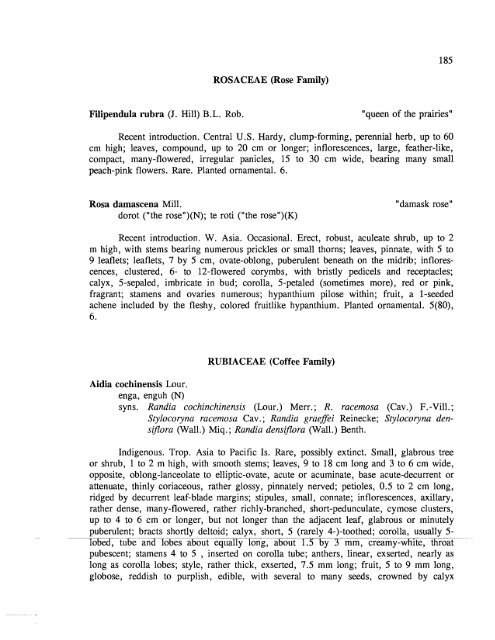atoll research bulletin no. 392 the flora of - Smithsonian Institution ...
atoll research bulletin no. 392 the flora of - Smithsonian Institution ...
atoll research bulletin no. 392 the flora of - Smithsonian Institution ...
Create successful ePaper yourself
Turn your PDF publications into a flip-book with our unique Google optimized e-Paper software.
ROSACEAE (Rose Family)<br />
Filipendula rubra (J. Hill) B.L. Rob. "queen <strong>of</strong> <strong>the</strong> prairies"<br />
Recent introduction. Central U.S. Hardy, clump-forming, perennial herb, up to 60<br />
cm high; leaves, compound, up to 20 cm or longer; inflorescences, large, fea<strong>the</strong>r-like,<br />
compact, many-flowered, irregular panicles, 15 to 30 cm wide, bearing many small<br />
peach-pink flowers. Rare. Planted ornamental. 6.<br />
Rosa damascena Mill.<br />
dorot ("<strong>the</strong> roseU)(N); te roti ("<strong>the</strong> roseW)(K)<br />
"damask rose"<br />
Recent introduction. W. Asia. Occasional. Erect, robust, aculeate shrub, up to 2<br />
m high, with stems bearing numerous prickles or small thorns; leaves, pinnate, with 5 to<br />
9 leaflets; leaflets, 7 by 5 cm, ovate-oblong, puberulent beneath on <strong>the</strong> midrib; inflores-<br />
cences, clustered, 6- to 12-flowered corymbs, with bristly pedicels and receptacles;<br />
calyx, 5-sepaled, imbricate in bud; corolla, 5-petaled (sometimes more), red or pink,<br />
fragrant; stamens and ovaries numerous; hypanthium pilose within; fruit, a 1-seeded<br />
achene included by <strong>the</strong> fleshy, colored fruitlike hypanthium. Planted ornamental. 5(80),<br />
6.<br />
RUBIACEAE (C<strong>of</strong>fee Family)<br />
Aidia cochinensis Lour.<br />
enga, enguh (N)<br />
syns. Randia cochinchinensis (Lour.) Merr. ; R. racemosa (Cav.) F. -Vill. ;<br />
Stylocoryna racemosa Cav. ; Randia graeflei Reinecke; Stylocoryna den-<br />
siflom (Wall.) Miq. ; Randia densi<strong>flora</strong> (Wall.) Benth.<br />
Indige<strong>no</strong>us. Trop. Asia to Pacific Is. Rare, possibly extinct. Small, glabrous tree<br />
or shrub, 1 to 2 m high, with smooth stems; leaves, 9 to 18 cm long and 3 to 6 cm wide,<br />
opposite, oblong-lanceolate to elliptic-ovate, acute or acuminate, base acute-decurrent or<br />
attenuate, thinly coriaceous, ra<strong>the</strong>r glossy, pinnately nerved; petioles, 0.5 to 2 cm long,<br />
ridged by decurrent leaf-blade margins; stipules, small, connate; inflorescences, axillary,<br />
ra<strong>the</strong>r dense, many-flowered, ra<strong>the</strong>r richly-branched, short-pedunculate, cymose clusters,<br />
up to 4 to 6 cm or longer, but <strong>no</strong>t longer than <strong>the</strong> adjacent leaf, glabrous or minutely<br />
puberulent; bracts shortly deltoid; calyx, short, 5 (rarely 4-)-too<strong>the</strong>d; corolla, usually 5-<br />
-lobed,tube-andlobesabGt equally long,--about 1.5 by 3 mm, creamy-white, throat<br />
pubescent; stamens 4 to 5 , inserted on corolla tube; an<strong>the</strong>rs, linear, exserted, nearly as<br />
long as corolla lobes; style, ra<strong>the</strong>r thick, exserted, 7.5 mm long; fruit, 5 to 9 mm long,<br />
globose, reddish to purplish, edible, with several to many seeds, crowned by calyx

















